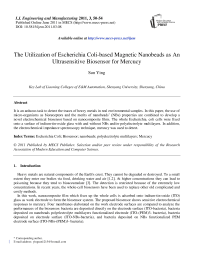The Utilization of Escherichia Coli-based Magnetic Nanobeads as An Ultrasensitive Biosensor for Mercucy
Автор: Sun Ying
Журнал: International Journal of Engineering and Manufacturing(IJEM) @ijem
Статья в выпуске: 3 vol.1, 2011 года.
Бесплатный доступ
It is an arduous task to detect the traces of heavy metals in real environmental samples. In this paper, the use of micro-organisms as bioreceptors and the merits of nanobeads’ (NBs) properties are combined to develop a novel electrochemical biosensor based on nanocomposite films. The whole Escherichia. coli cells were fixed onto a surface of indium-tin-oxide glass with and without NBs and/or polyelectrolyte multilayers. In addition, the electrochemical impedance spectroscopy technique, mercury was used to detect.
Escherichia Coli, Biosensor, nanobeads, polyelectrolyte multilayers, Mercucy
Короткий адрес: https://sciup.org/15014134
IDR: 15014134
Список литературы The Utilization of Escherichia Coli-based Magnetic Nanobeads as An Ultrasensitive Biosensor for Mercucy
- H. Abu Qdaisa and H. Moussab, “Removal of heavy metals from wastewater by membrane processes: a comparative study, ” Desalination. USA, vol. 164, 2004, pp. 105–110.
- W.C. Leung, M.F. Wong, H. Chua, W. Lo and C.K. Leung, “Removal and recovery of heavy metals by bacteria isolated from activated sludge treating industrial effluents and municipal wastewater,” Water Sci. Technol. Eng., vol. 41, (2000), pp. 233–240.
- S.I. Abu-Eishah, “Removal of Zn, Cd, and Pb ions from water by Sarooj clay,” Appl. Clay Sci. vol. 42, 2008, pp. 201–205.
- J. J. Ackman and M. A. Seitz, “Methods of complex impedance measurements in biological tissues, ” CRC Crit. Rev. Biomed. Eng., vol. 11, 1984, pp. 281-311.
- J. R. Macdonald, “Impedance Spectroscopy: Emphasizing Solid Materials and Systems,” John Wiley & Sons. NewYork. 1987, pp. 346.
- M. I. N. Zhang and J. M. H. Willison, “Electrical impedance analysis in plant tissues: A double shell model,” J. Exp. Bot. vol. 42, 1991, pp. 1465-1475.


